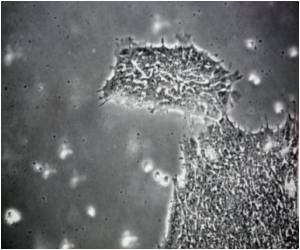Cancer cells are known for causing trouble, mostly because they multiply recklessly, don't seem to die, and metastasize to different places where they don't belong.

Lu's research team first identified iASPP as an inhibitor of p53 in 2003. In the current study, Lu and her colleagues show that a protein complex named cyclin B1/cdk1, which is expressed at high levels in the cytoplasm of advanced melanomas, induces a pair of precise chemical modifications on iASPP to activate the protein. When activated, iASPP is shuttled into the nucleus, binds to p53 and ultimately inhibits its ability to induce cell suicide. "This is the first time that such a mechanism of p53 inactivation has been described," says Lu.
Lu and her colleagues explored whether they could restore p53's function in advanced melanomas by scuttling iASPP activation. To do so, they treated melanoma cells with a panel of small molecules and identified JNJ-7706621 (JNJ) as the best inhibitor of cyclinB1/cdk1. Lu's study showed that p53 is inhibited by two proteins in melanoma cells, iASPP and MDM2. The activity of the latter protein is known to be blocked by a small molecule called Nutlin-3. When JNJ and the Nutlin-3 were combined, the full function of p53 was restored in metastatic melanoma cells. Further, such treatment significantly suppressed tumor growth in mice.
"These results demonstrate that functional p53 in melanoma is normally inhibited by two different factors, instead of one, as previously thought. They also provide a proof of principle that both of those factors need to be blocked if p53 is to be successfully reactivated in cancer cells," said Lu.
Since multiple signaling pathways drive the growth of tumor cells, Lu and her colleagues wondered if the restoration of p53 function could be used as a strategy to enhance existing cancer therapies that target parallel signaling pathways. To find out, they treated advanced melanomas with JNJ, Nutlin-3 and a chemotherapeutic drug used in the clinic today named vemurafenib. This drug specifically inhibits BRAFV600E, a mutated protein that drives cancer cell proliferation. With such treatment, advanced melanoma tumors in preclinical mouse models shrank by a full 75 percent after 28 days of treatment. This has notable implications for the treatment of cancers in which p53 is not mutated but is instead functionally silenced—roughly half of all cancer cases.
Based on their results, Lu and her colleagues argue that the best strategy in such cases might be to use drug combinations that target multiple, parallel pathways involved in tumor development and maintenance. Such combinations of drugs that normally have short-term efficacy could achieve an additive, if not a long-term synergistic effect.
Advertisement
Source-Eurekalert











